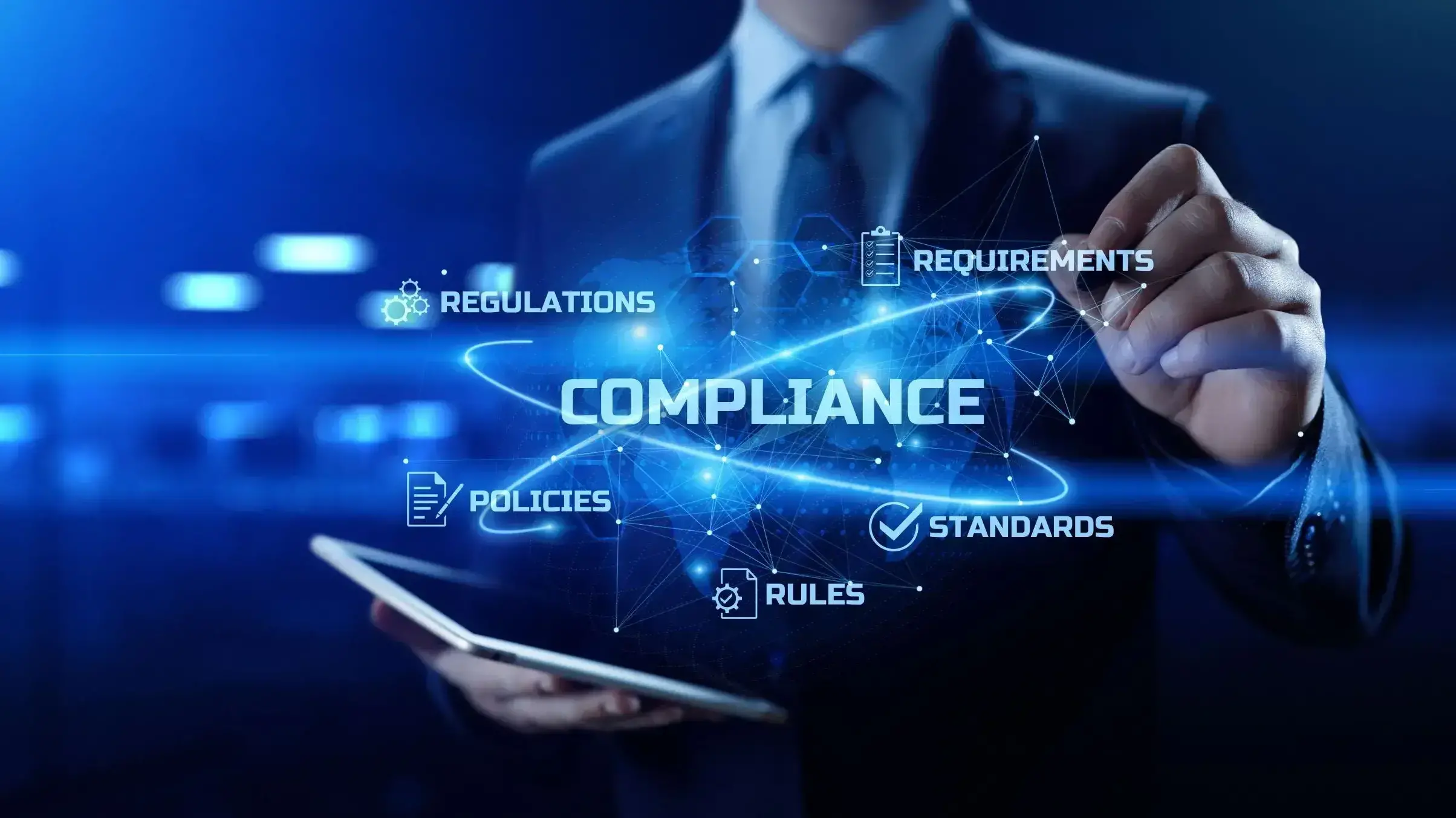As regulatory demands grow, businesses face the continuous challenge of ensuring compliance. Compliance as a Service (CaaS) provides an efficient cloud-based solution, automating the compliance process and reducing the operational burden on businesses.
This article discusses the mechanisms of CaaS, its benefits, and the role of emerging technologies in enhancing its effectiveness.
How Compliance as a Service Works
Compliance as a Service (CaaS) is a cloud-based solution that helps businesses manage and maintain regulatory compliance through automated tools and expert services. The working mechanism of CaaS involves several key components that interact to ensure continuous and efficient compliance management.
1. Initial Assessment
CaaS providers start by conducting an initial assessment of a company's current compliance status. This involves identifying the specific regulations that the company must adhere to, based on its industry, size, and the jurisdictions in which it operates. The assessment also helps pinpoint any compliance gaps or areas of risk that need addressing.
2. Customization and Integration
Based on the initial assessment, the CaaS provider customizes their services to meet the specific needs of the business. This often includes configuring the CaaS software to integrate seamlessly with the company’s existing IT infrastructure, such as ERP systems, CRM tools, and other business applications. Integration ensures that data flows smoothly between systems, facilitating real-time compliance monitoring and reporting.
3. Automated Compliance Tools
CaaS utilizes a suite of automated tools to handle various compliance tasks. These tools include:
Automated Monitoring: Continuously scans business processes and data to ensure they comply with relevant laws and regulations. This monitoring covers everything from data protection practices to financial transactions.
Risk Management Software: Identifies and assesses potential compliance risks, helping companies prioritize their mitigation efforts.
Reporting and Documentation: Automatically generates necessary reports and maintains records that can be crucial for audit purposes and regulatory inspections.
4. Regular Updates and Advisory
Regulatory environments are dynamic, with frequent updates and changes. CaaS providers stay abreast of these changes and update their systems accordingly.
This ensures that a company’s compliance program remains current without the need for manual intervention. Additionally, CaaS often includes advisory services, where compliance experts offer guidance on best practices and help resolve specific compliance issues as they arise.
5. Training and Support
CaaS providers also offer training programs for a company's staff to ensure they understand compliance requirements and how to adhere to them using the tools provided. Ongoing support is typically available to help address any operational issues, ensuring that compliance processes run smoothly at all times.
6. Continuous Improvement
Using data analytics and compliance reporting, CaaS can help businesses identify areas for improvement in their compliance practices. This continuous feedback loop allows companies to enhance their compliance posture over time, adapting to new challenges and maintaining robust compliance protocols.
Benefits of CaaS
- Cost Efficiency: CaaS providers offer scalable solutions, allowing businesses to access compliance expertise without requiring extensive in-house resources. This reduces overhead costs associated with maintaining dedicated compliance teams and infrastructure.
- Expertise Access: CaaS grants businesses access to specialized compliance professionals with deep knowledge of regulatory requirements and industry best practices. Leveraging this expertise ensures thorough compliance management and reduces the risk of non-compliance.
Risk Mitigation: By staying abreast of regulatory changes and implementing proactive compliance measures, CaaS helps mitigate the risk of legal penalties, fines, and reputational damage resulting from non-compliance incidents.
Operational Efficiency: CaaS streamlines compliance processes through automation, standardized procedures, and efficient workflows. This improves operational efficiency by reducing manual effort, minimizing errors, and optimizing resource allocation.
Focus on Core Business: Outsourcing compliance functions to CaaS providers allows businesses to focus on their core activities and strategic objectives. By relieving the burden of compliance management, organizations can allocate more time and resources to driving innovation and growth.
Enhanced Compliance Culture: Through training programs and educational resources, CaaS fosters a culture of compliance within organizations, promoting employee awareness and accountability. This proactive approach reduces the likelihood of compliance breaches and encourages a commitment to ethical conduct.
Regulatory Assurance: By engaging reputable CaaS providers with a track record of success, businesses gain assurance that their compliance needs are being met effectively. This peace of mind enables organizations to navigate regulatory complexities confidently and focus on achieving strategic objectives.
The Role of Technology in Compliance as a Service (CaaS)
1. Compliance Management Software: Technology enables the development and deployment of compliance management software platforms, which centralize and automate compliance-related tasks such as policy management, risk assessment, monitoring, and reporting.
2. Data Analytics: Technology enables CaaS providers to use data analytics for identifying compliance risks or improvement opportunities by analyzing data trends and making informed decisions.
3. Automation Tools: Automation technologies like RPA and workflow automation, along with CaaS solutions, enhance efficiency and accuracy by streamlining repetitive tasks and automating compliance processes.
4. Regulatory Intelligence Platforms: Regulatory intelligence platforms aggregate data from diverse sources to offer CaaS providers real-time updates on regulatory changes, aiding in adapting compliance strategies.
5. Cloud Computing: Cloud computing facilitates CaaS deployment as SaaS platforms, offering flexible, scalable, and cost-effective tools for compliance management accessible anytime, anywhere.
6. Blockchain Technology: Blockchain technology's tamper-resistant and transparent features can improve compliance in supply chain management, regulatory reporting, and data privacy by ensuring the integrity and authenticity of data and transactions for CaaS providers.
7. Integration with Existing Systems: Technology enables seamless integration between CaaS platforms and existing systems like ERP, CRM, and document management, enhancing data sharing, reducing silos, and improving compliance information accuracy across organizations.
Industries And Sectors Leveraging CaaS
1. Retail: Retailers use Content as a Service (CaaS) to streamline product information management across various channels, ensuring consistency in messaging and branding while efficiently updating inventory and pricing information.
2. Hospitality and Tourism: In the hospitality sector, CaaS facilitates the creation and distribution of engaging content for hotel websites, booking platforms, and travel guides. This content enhances guest experiences by delivering relevant information about accommodations, amenities, and local attractions.
3. Education and E-learning: Educational institutions and e-learning platforms leverage CaaS to develop and deliver multimedia educational content, allowing for adaptive learning experiences, interactive materials, and continuous updates to align with curriculum changes and learning objectives.
4. Healthcare: Healthcare organizations adopt CaaS to manage medical content for patient education, physician training, and healthcare marketing, ensuring accurate and up-to-date information dissemination while adhering to regulatory compliance and patient privacy standards.
5. Manufacturing: Manufacturers utilize CaaS to create and distribute product documentation, training materials, and marketing collateral. This enables efficient collaboration among global teams, enhances product knowledge dissemination, and improves after-sales support services.
6. Finance and Banking: Financial institutions employ CaaS to deliver financial news, market analysis, and personalized investment advice across digital channels, enhancing customer engagement, brand loyalty, and financial literacy through timely and relevant content delivery.
7. Real Estate: Real estate agencies leverage CaaS to showcase property listings, virtual tours, and neighbourhood insights on websites and property portals. This facilitates informed decision-making for buyers, renters, and investors while optimising marketing and lead generation strategies.
CaaS supports businesses in maintaining compliance and enhances their ability to focus on core activities by reducing the complexities associated with regulatory adherence. Its scalability ensures that as businesses grow, their compliance frameworks can grow with them, adapting to new challenges and markets efficiently.
Implementing CaaS in Your Business
Implementing Compliance as a Service (CaaS) within an existing IT infrastructure requires careful planning and execution to ensure seamless integration and functionality.
Begin by thoroughly assessing your existing IT infrastructure to understand what systems are in place, how they are used, and where compliance-related data flows occur.
Determine which systems need to directly interact with the CaaS solution, such as ERP systems, CRM software, human resources platforms, and financial systems.
Choose a provider with flexible integration options, industry experience, and robust support. Ensure compatibility with standard data exchange protocols and APIs.
Develop a detailed integration strategy that outlines how the CaaS solution will connect with your systems. This should include technical specifications, data flow diagrams, and an implementation timeline.
Before full-scale integration, set up a test environment to trial the CaaS implementation. This allows you to identify and address potential issues without affecting your live environment.
Once testing is successful and all adjustments are made, proceed with full integration. This includes setting up all connections, data flows, and user access controls as defined in your strategy.
Keep detailed documentation of the integration process and configurations for future reference and troubleshooting.
Educate your team about how to use the new CaaS features. Training should cover both the technical aspects of how to interact with the new tools and the compliance aspects they manage.
Establish a feedback mechanism to capture users' experiences and issues encountered during the early stages of implementation.
Continuously monitor the integration to ensure that it functions as intended. Watch for any issues that could impact data accuracy or compliance reporting.
Ensure continuous support from your CaaS provider for technical challenges and regulatory updates. Regularly review the integration’s effectiveness and optimize as needed.
Comparative Analysis Between Compliance as a Service (CaaS) and Traditional Compliance Methods
| Feature | Traditional Compliance | Compliance as a Service (CaaS) |
|---|---|---|
| Cost Efficiency | High operational costs due to in-house resources. | Reduced costs through outsourcing and economies of scale. |
| Expertise Access | Dependent on internal hiring and retention. | Access to specialized expertise regardless of location. |
| Scalability | Scaling requires significant resource investment. | Easily scalable to meet changing needs with minimal cost. |
| Technology Utilization | Limited by internal resources and budgets. | Leverages advanced technologies like AI and blockchain. |
| Risk Management | Reactive, based on manual monitoring. | Proactive, with continuous monitoring and real-time updates. |
| Regulatory Updates | Manual updates can lead to delays. | Automatic and immediate updates ensure continuous compliance. |
| Integration and Support | Often complex and resource-intensive. | Smoother integration and comprehensive support are provided. |
Best Practices for Implementing CaaS
Implementing Compliance as a Service (CaaS) effectively requires a strategic approach to ensure it aligns with your organization's compliance needs and integrates smoothly with existing systems.
Identify Compliance Requirements: Understand the specific regulatory frameworks relevant to your industry, location, and size.
Select the Right Provider: Choose an experienced provider with scalable solutions and seamless integration capabilities.
Develop an Integration Strategy: Outline technical specifications, data flow diagrams, and implementation timelines, ensuring data consistency and protection.
Provide Comprehensive Training: Conduct initial and ongoing training for employees on new tools and compliance processes.
Monitor Performance: Regularly monitor and audit the CaaS implementation to ensure it meets compliance needs.
Promote a Culture of Compliance: Foster a compliance-focused culture through regular communication and incentives for maintaining standards.
Challenges When Implementing CaaS
1. Integration Complexity: Employ flexible CaaS solutions that offer robust APIs for easier integration with existing IT systems. Plan and execute a phased integration process to manage complexities efficiently.
2. Data Security Concerns: Ensure the CaaS provider adheres to stringent security protocols and complies with relevant data protection standards. Regular security audits and transparency in security practices are vital.
3. Regulatory Compliance: Opt for CaaS providers who dynamically update their platforms to reflect current regulations, ensuring continuous compliance with evolving laws.
4. Cost Management: Understand all potential costs involved, including setup, subscription, and operational costs. Choose providers with clear, scalable pricing models that align with business size and needs.
5. Resistance to Change: Implement comprehensive training programs and change management strategies to support employees during the transition. Communicate the benefits to all stakeholders to mitigate resistance.
6. Dependency on Vendor: Establish a robust service level agreement (SLA) with the CaaS provider to ensure quality and reliability. Always have an exit strategy to mitigate risks associated with dependency.
Companies that have Successfully Implemented Compliance as a Service (CaaS)
1. Novant Health
Novant Health, a major U.S. healthcare network, partnered with Clearwater Compliance to manage HIPAA regulations. By using Clearwater's CaaS solution, which included automated risk assessments and continuous monitoring, Novant Health reduced its risk of data breaches and regulatory violations, allowing healthcare professionals to focus more on patient care.
2. Swedbank
Swedbank, a leading Swedish bank, faced challenges with anti-money laundering (AML) compliance. By adopting Fenergo's CaaS solution, Swedbank automated client lifecycle management and regulatory reporting. This improved compliance with AML regulations enhanced operational efficiency and reduced manual compliance costs.
3. British Airways
British Airways needed to comply with the EU's GDPR due to its large volume of personal data. Collaborating with OneTrust, British Airways implemented a robust GDPR compliance program that included data mapping and risk assessments. This partnership helped the airline manage GDPR compliance efficiently, reducing the risk of fines and building customer trust.
Future Trends in CaaS
1. AI and Machine Learning Integration: AI and machine learning will automate compliance processes, enhance accuracy in detecting breaches, and predict potential risks. These technologies will streamline audits, manage regulatory updates in real-time, and continuously improve compliance systems.
2. Blockchain for Transparency: Blockchain will improve transparency and traceability in compliance by providing immutable records of compliance activities. This technology will ensure accurate audit trails, reduce fraud risk, and enhance stakeholder trust.
3. Real-time Monitoring and Reporting: Real-time monitoring and reporting will enable organizations to identify and address compliance issues immediately. Dashboards and alerts will provide up-to-date information, allowing swift corrective actions and reducing the risk of breaches.
4. Customized Compliance Solutions: The demand for industry-specific compliance solutions will grow. CaaS providers will offer tailored services for sectors like healthcare, finance, and retail, addressing unique regulatory challenges and ensuring effective compliance management.
Conclusion
CaaS (Compliance as a Service) has revolutionized the regulatory compliance process through specialization, efficiency, and risk mitigation. By leveraging AI and machine learning, CaaS offers high-performance compliance management, enabling organizations to proactively address regulatory challenges and foster a culture of continuous improvement.
As the regulatory landscape evolves, adopting CaaS is a strategic way to achieve operational excellence and sustainable growth. Explore how CaaS can transform compliance management in your organization.
Frequently Asked Questions
What is Compliance as a Service (CaaS) and how does it help with regulatory compliance requirements?
Compliance as a Service (CaaS) is a cloud-based solution that helps businesses manage and maintain regulatory compliance through automated tools and expert services. CaaS ensures that organizations meet regulatory compliance requirements by providing proactive compliance support, automating compliance management, and keeping up with applicable regulations.
How does CaaS ensure compliance with complex regulations like the General Data Protection Regulation (GDPR) and the California Consumer Privacy Act (CCPA)?
CaaS ensures compliance with complex regulations such as GDPR and CCPA by offering a comprehensive compliance framework. This framework includes regular updates on regulatory changes, tools to automate compliance processes, and support from compliance experts who help identify and address compliance gaps. This proactive approach helps businesses stay compliant with data protection laws and mitigate compliance risks
What are the benefits of using CaaS for managing complex compliance requirements in financial institutions?
For financial institutions, CaaS offers several benefits, including the ability to manage complex compliance requirements related to the Bank Secrecy Act, PCI DSS, and other financial regulations. CaaS provides automated tools for monitoring and reporting, reducing the burden on in-house compliance teams, and ensuring audit readiness. It also helps protect sensitive data, reduce security risks, and improve the organization’s overall security posture.

Yetunde Salami is a seasoned technical writer with expertise in the hosting industry. With 8 years of experience in the field, she has a deep understanding of complex technical concepts and the ability to communicate them clearly and concisely to a wide range of audiences. At Verpex Hosting, she is responsible for writing blog posts, knowledgebase articles, and other resources that help customers understand and use the company's products and services. When she is not writing, Yetunde is an avid reader of romance novels and enjoys fine dining.
View all posts by Yetunde Salami




















